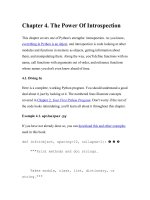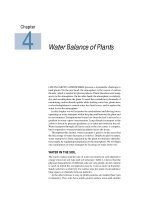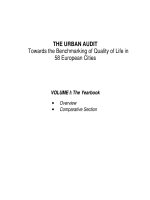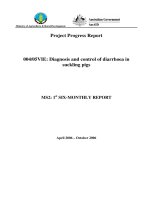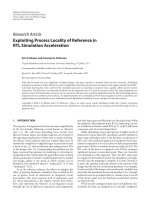CHAPTER 4: THE CONCEPT OF MEASUREMENT IN THE MARKETING RESEARCH docx
Bạn đang xem bản rút gọn của tài liệu. Xem và tải ngay bản đầy đủ của tài liệu tại đây (626.54 KB, 36 trang )
1
CHAPTER 4
THE CONCEPT OF MEASUREMENT
IN THE MARKETING RESEARCH
H CHÍ MINH CITY UNIVERSITY OF INDUSTRYỒ
FACULTY OF BUSINESS ADMINISTRATION
MARKETING
RESEARCH
2
CONTENTS
The concept of measurement;
1. What is measured?;
2. The benefits of the measurement;
3. The laws (rules) of measurement;
4. Measure scales;
5. Three standards of a measurement;
6. Psychological measure;
The review questions.
3
For the reflection or describing, with
accuracy, an appearance (substance, quantity);
material or psychological status of the research
subject, are needed to measure them as
definite standards.
The measurement is not only the definite size
of physical dimension but also whatever
concepts, which can be compared each other.
The measurement is an indispensable tool to
marketing research.
THE CONCEPT OF MEASUREMENT
THE CONCEPT OF MEASUREMENT
In the range of the subject (Marketing research) is the
measurement objects that we care essentially as: Social
– economic phenomenon and human psychological
status.
4
1. WHAT IS MEASURED?
Measurement
of physical
phenomenon
Measurement of
human psychological
status.
Measurement of
Social – economic
phenomenon
5
2. The benefit of the measurement
1. Defining accuracy and quantity or level of physical;
economic; human society; or psychology
2. Comparing difference between things, human, or
attitude
3. Easily to subgroup, classify, arrange, statistic, calculate
of rate
6
3. The laws (rules) of measurement
Example 2:
That amount loyal to brands with scores from 1 to 7. 7
points is always only buy goods with trademark use (if
this store will not have to go find somewhere else to buy
or when to buy new). Point 1 is the ever-changing brand.
In addition to the points 2,3,4,5,6 are instructions for
specific points .
Example 1:
Measuring the time “go to shopping” has to stipulate that is
the time from going into the supermarket to paying and
leaving.
4. Measure scale kinds
There’re 4 kinds of basic measure scales
Ratio
Norminal
Ordinal
Interval
8
4.1 The Nominal scale
Nominal Scale is most simple Scale to distinguish
things or this phenomenon from its something else, much
of them, when they take digits to encode or point
(nominal) is a matter, in addition there isn't another what
idea.
Usable statistics operations with nominal scale are:
Count;
Frequency Counting (of 1 event);
Define mode value;
To execute verification;
9
4.1 The Nominal scale
Some examples of nominal scale:
EX 1 :
-
Customer: male female;
-
Object: Wholesalers Retailers
- Attitude: Like Dislike
Among the nominals: Male / Female; like / dislike
completely unrelated things at all levels.
10
4.1 The Nominal scale
Some examples of nominal scale:
EX 2: Ask “Please indicate the presently status of your
marriage?”
Single 1
Get married 2
Widowerhood 3
Divorce 4
These numbers are nominal identifier because
clearly you can not the plus or to measure the average of
“marriage status”.
11
4.2 The Ordinal scale
Used to rank the objects or phenomenons in a certain
order to compare to that of the first level or less than, but
not for quantitative data, we do not know the distance
between them.
So, the ordinal scale is the nominal scale, but not any
nominal scales are also ordinal scale.
For that ordinal scale, center tendency can consider
using the median point ; value Mode; and dispersion is only
measured by interval and interquartile range but use less.
12
4.2 The Ordinal scale
Example of the ordinal scale :
Rating TOPTEN Consumer Vietnam according to
the number of mail clients vote more or less from first
class to class 10 (not the class is how many messages). Or
preferred level of customers in 3 levels:
Dislike
Like slightly
Very like.
You know as "like slightly" more than “dislike" but
does not measure the distance between the two levels is
how many.
4.3 The Interval scale
is a kind of scale to provide quantum
about order relations between things
and phenomenons;
is a special kind of the ordinal scale;
In measuring attitudes or opinions, the
interval scale provides more information
than ordinal scale.
The Interval scale
shows distance (quantification) between
two ordinals.
14
4.3 The Interval scale
Example of the interval scale :
Ex 1: Stating your taste about a color or style of product
by marking in the interval scale:
1 2 3 4 5 6 7 8 9 10
Dislike Very like
By then, they define their attitude correctly get into
which mark .
15
4.3 The Interval scale
Example of the interval scale :
Ex 2: Answer the question: “You are willing to pay more
how many % to buy a new product in comparing with the
current sale price of old product ”.
Interviewee will answer : 5%; 10%; or 20%;
The level of rates show that the distance between
different answers are wrong how many %.
The interval scale provides more information
than ordinal scale.
16
4.3 The Interval scale
The statistics operations can be used to extra of this
scale (compare with two above scales) as:
To calculate the variability;
Average value;
Deviation standard.
Noting: The Interval scale does not have absolute 0
point itself, so you can only do addition or subtraction (+/-),
if using division (/), the results will be meanless.
17
4.4 The Ratio scale
The Ratio scale has all of particularity of the interval
scale. Moreover, the 0 point in the ratio scale is a value
"true“. So we can use division to calculate the rate for the
purpose of comparison. It mean that comparing this value
with the other one.
Ex 1:My watching video time is 2 times (by 200%) than time TV
viewing .
Ex 2: The level of expenditure of funds for the children’s school
fee makes up 30% of my income.
These types of measurement scales assess and
compare the physical phenomenon absolutely (the amount -
quality), provide quantitative information as fully and
applied most widely. Many Ratio scales , the meaning is
deeper than three Ratio scales before .
18
4.4 The Ratio scale
In general the variables used interval scale and ratio
scale, we can determine the value of central tendency, such
as: average; frequency; Trends also distributed as:
Deviation standard, the variance is little used to. So, in
SPSS added up common 2 types (interval scale and ratio
scale) is one (Measure scale).
In fact, to have a comprehensive vision, each question
usually applies a measure scale for these answers, or a total
measure scale for that all .
19
5. Three standards of a measurement
Reliability
Validity
Sensitivity
20
5.1 Reliability
The measurement can repeat many times and for
the same results or consistent, stable in the identical
conditions. We must try to eliminate the exotic factors
change the measurement conditions .
In fact, to ensure reliability before the "official
research", who usually conduct "preliminary research" on
a limited form, results from "preliminary research“ are
tested ( called tested measure scale). Cronbach Alpha tool
in SPSS is a good example in this case. With the value of
the tested measure scale is greater 0.65 is the measure
scale can be used (ensures reliability). Conversely, it must
be adjusted them.
21
5.2 Validity
The measurement have to achieve the target that we want
to measure.
Ex 1: Testing is the measurement of knowledge students
obtained through their lesson. Therefore, the exam
question is outside program or the partial markers, that
students get a good mark while they do not learn, or
understand their lesson.So that the validity is not exactly.
Ex 2: Ask: “What brand car would you buy if you won in
the lottery ?” This question isn’t valid because the
interviewee has rather won in the lottery. Instead they have
just learnt about people who bought car or asset or real
account.
22
5.3 Sensitivity
The sensitivity is specially important in the
psychological measurement when it has a precise change in
the different psychology status.
Ex: Ask “ do you agree or not ?”, The interviewee can be
embarrassed
The answer will satisfy more levels,if we advance the
measure scale with many levels as:
Completely Agree
Agree
Not agree also not oppose
A part disagree
Completely disagree
23
The human psychological measure
status is always difficult, most complex.
When research on psychology of
consumers, we want to measure attitudes of
the objects with the observation, interview or
test .
Researchers can use machines to psychology
measure through reactions of skin, blood pressure, heart
rate, and pupil of the eyes, the senses of man. However,
in the interview we usually apply the attitude scales .
6.
6. Psychological measure
24
6.1 The normal psychological measure
In the psychological measure status, can use some
kinds of scales (developed from 4 basic scales) as:
Binary Scale
Article Scale;
Likert Scale;
Ordinal Scale;
Mark Scale
Stapel Scale;
Points unchanged total scale;
Unlimited Scale;
Picture Scale.
25
Binary Scale
Format with 2 distinguishable and opposite categories
each other :
Yes No
True False
Agree Disagree
Good Bad
Many Little


